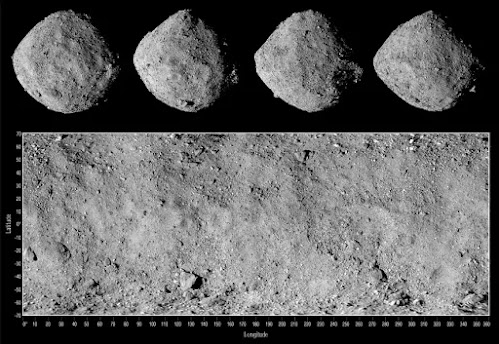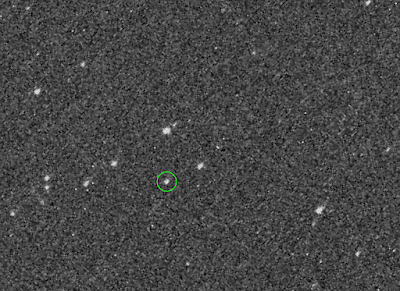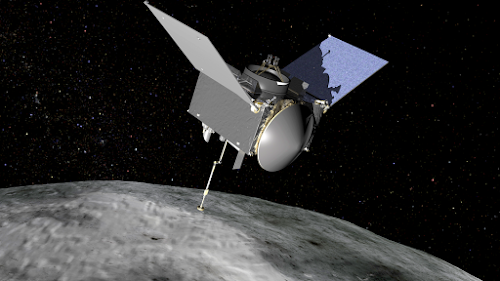Is there any threat to Earth with Asteroid Bennu? | Will NASA trace out the origin of the life on Earth?
Asteroids
are the building blocks of our solar system and they carry hidden mysteries of
the Universe. Asteroid Bennu is a carbonaceous asteroid means that it contains
mostly carbon, which is associated with life. It's not just about carrying the possibilities
of life but also carrying the possibilities of death. Bennu is a smaller
asteroid compared to that of asteroid which killed dinosaurs, but can cause a
huge amount of damage to the area that effected. It is a type of asteroid (NEO) that
shares same region of space as Earth (Around obit of Sun). For every six years
it gets close to the Earth which actually increasing the chances to hit and
damage the Earth. So to understand whether it has possibilities to hit the Earth
or not, we have to study it.
 |
| Bennu_four_sides_Into_the_dark_space Image credit: NASA/Goddard/University of Arizona |
When
astronomers discovered Bennu they also discovered that, it has higher chances
to hit Earth. It is in the list of potentially hazardous objects that will hit Earth
soon. So to know the orbit of Bennu scientists have to know the exact location,
shape and size of asteroid Bennu.
One
of the reason that causing Bennu to hit the Earth is Yarkovsky effect which causes
every rotating object in the solar system to change orbit a little bit. When
Sun light strikes the Bennu (due to emitted thermal photons which carry momentum),
it acts like a bit of thrust accelerating the orbital motion of Bennu. So Yarkovsky effect influencing the Bennu's path.
 |
| OSIRIS-REx_first_image_of_asteroid_Bennu_Into_the_dark_space Image credit: NASA/Goddard/University of Arizona |
On 8
September 2016, NASA launched a spaceprobe called OSIRIS-REx which is a sample
return mission to study the asteroid Bennu. After crossing the Moon's orbit, it
started to orbit the Sun. On 3 December 2018, it reached asteroid Bennu which
is nearly 500 meters wide. From there it started scanning the surface creating
a total map of the asteroid Bennu. It takes 62 hours for the OSIRIS-REx to
orbit Bennu at an altitude of 1.75 kms above the surface. Since then scientists
are studying Bennu by information obtained from OSIRIS-REx and finding the best
landing sites which has interesting geology to collect samples.
It
will collect 60 grams of sample from asteroid by a new technology called TAGSAM
(by robotic arm) meaning Touch-and-Go Sample Acquisition Mechanism. With this
sample collected in a protected box (from contamination), it will return back
to Earth which helps scientists to find organic compounds. But OSIRIS-REx
already spotted some dynamic activity on the Bennu.
 |
| OSIRIS-REx_artist’s_concept_Into_the_dark_space Image credit: NASA |
However,
OSIRIS-REx has already selected the best landing sites to collect samples named
as Osprey, Kingfisher, Nightingale and Sandpiper. But recently on 12 December 2019,
NASA chosen best landing spot named as Nightingale. Recently NASA said that
they will make their first attempt on October 20, 2020. It will make a total of
3 attempts to collect the samples. After successful collection of the samples
and if it isn't crashed in any of the attempts, it will return back to the Earth
with the capsule containing samples. It will travel for a total of 2 years to the
Earth and on 23 September 2023, the capsule will safely reach the Earth.
On 2
march 2004, a spaceprobe called Rosetta was launched by ESA to study a comet
called 67P. On 6 August 2014, it reached comet and performed series of landings
(trials). Later on 30 September 2016, the mission was ended in a disaster by
hard landing on comet. But OSIRIS-REx have still sample collection part to go.
If it is successful, then this mission will serve as a masterpiece in finding
the origin of life on Earth. Let us wait for it.
Share your ideas and thoughts in comment section below.
For more information click here and for updates please follow my site,
Thank you.
Interesting
ReplyDeletethank you
Delete